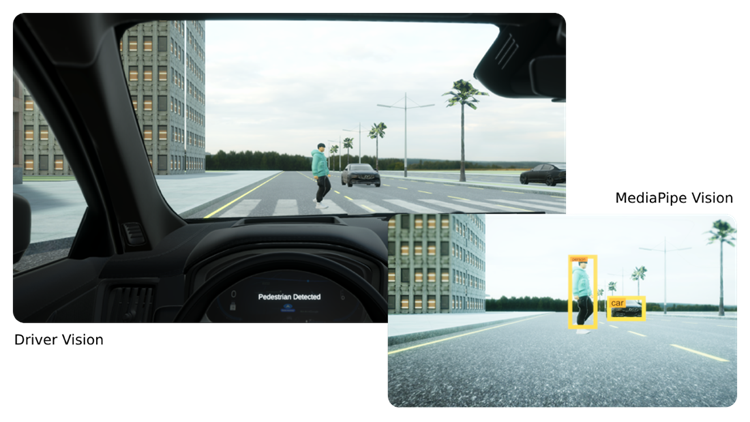Introduction
The automotive industry has long been synonymous with innovation and progress, but in recent years, a transformative wave has been sweeping through it, remodeling the way we perceive and interact with vehicles. At the front of this revolution are the twin forces of artificial intelligence (AI) and modern technology. In this blog, we’ll delve into the current state of the automotive industry, highlighting the pivotal role that AI and technology play in shaping its future. To make it more exciting, we are also going to give you a quick demo of a simple project that we made, that uses an object detection model to prevent vehicular heatstroke and warn the driver about forgotten items in the car.
Real Use Cases
AI’s integration into the automotive sector has been nothing short of revolutionary, touching upon various aspects of the industry. From the inception of a car’s design to its production on the assembly line, Generative AI (GenAI) is leaving a permanent mark. It aids in the creative process, clearly defining and streamlining design elements, while also optimizing production processes for greater efficiency.
Furthermore, AI is no longer just a behind-the-scenes player. It is actively engaging with drivers on a personal level, offering personalized treatment and services. Imagine a car that anticipates your needs, predicting your route, and offering tailored recommendations for services and marketplace offerings along the way, all without you having to input a destination. This level of customization is becoming a hallmark of AI-driven automotive technology.
Finally, it’s not new that AI is also present in autonomous vehicles (AV). They make driving more natural for the user and improve the decision-making algorithm. But there is one use case that is not very often mentioned, that combines GenAI and digital twins. Researchers are using generative AI, specifically neural radiance field (NeRF), and more recently Gaussian Splatting, technology, to create fully interactive 3D simulations from recorded sensor data. These digital twin environments and synthetic data generation help in developing, testing, and validating autonomous vehicles at a large scale.
Proof of Concept Presentation
To have a better understanding of the power of AI technologies in vehicles and to gain knowledge of what is viable to implement, we’ve created a simple 3D environment with a car to simulate real-life behaviors.
The first thing we implemented is what we called “entity detector”, or objects detector, which identifies overlooked things within the vehicle, ranging from pets and bags to infants. This is accomplished through the utilization of an object recognition model from Google’s MediaPipe. Essentially, the entity detector serves as a vigilant assistant, promptly alerting drivers to potential concerns. Our goal with this project was to create a simplified environment to assess the capabilities and viability of AI in the automotive realm, and the results are both interesting and promising.
For the visualization, we used the game engine Unity, which allowed us to create realistic environments and iterate fast. It's important to note that the engine is only used for graphics and not used in any way to provide object recognition/detection. The rendered images are sent to MediaPipe, which returns the results to be interpreted by the engine.
Demo
The first scenario we created was a complete flow of basic object detection, as shown in the video below.
Demo video (Sources: dog, audio effects, boy, backpack, car, exterior)
To test other MediaPipe capabilities, we added a pedestrian and car detection system.

Wrap Up
At the intersection of AI and technology, the automotive industry is paving the way for a future of smarter, safer, and more intuitive driving experiences. From comprehensive AI integration in vehicle design and manufacturing to the provision of personalized services, AI is playing an instrumental role in reshaping the landscape of the sector. The introduction of advanced technologies like GenAI and digital twin simulations is also setting the stage for large scale deployment of autonomous vehicles. Our simple demo showed just a glimpse of the future, where AI can help prevent unfortunate incidents like vehicular heatstroke or forgetting items, by promptly alerting the driver.
Technology and Artificial Intelligence are proving to be the powerhouse behind the revolution in the automotive industry. The advances we are seeing today are only the beginning of a new era, one in which cars become more than just vehicles for transport, but personalized companions catering to the individual needs of their passengers.
Key Findings
- AI, through Generative AI and digital twins, is revolutionizing the phase from inception of a car’s design to its production. It is optimizing design elements and production processes, making them more efficient.
- AI is now a front-end player in vehicles, offering customized services and marketplace offerings. It is even capable of predicting your route without input and tailoring services accordingly.
- Autonomous vehicles are improving user experience and decision-making abilities, thanks to AI.
Acknowledgement
This piece was written by João Pedro São Gregório Silva & Vinicius Assis Lima at Encora.